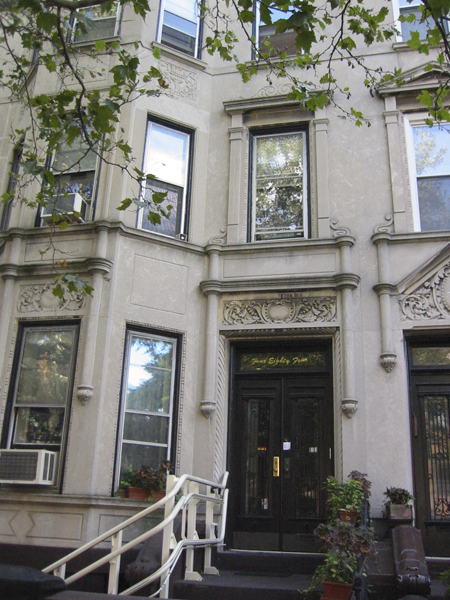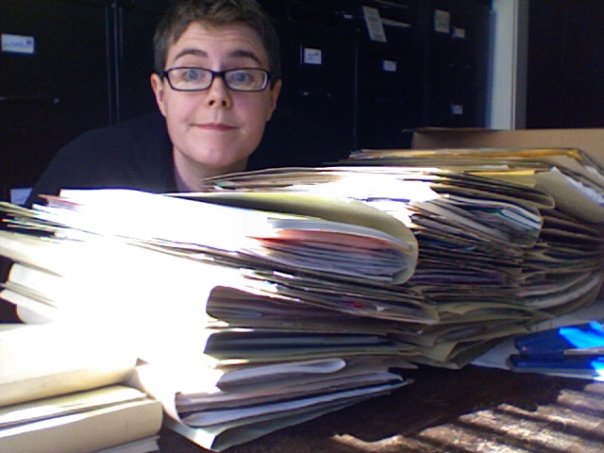Still in-progress…
In my own research on lesbian-queer spaces, economies, and cultures, I sought to collect archival data to tell the more multiple stories of lesbians and queer women in as much as I could across their wide-ranging activisms and interests. The research for A Queer New York and this website involved conducting multi-generational focus groups with forty-seven lesbians and queers who came out between 1983 and 2008 and a year’s worth of archival research on lesbian-queer publications and organizations at the Lesbian Herstory Archives.
Accumulating History in a Spreadsheet
As I accumulated a vast set of archival notes, I realized that there were patterns within them–statistical and geographical–that could help me visualize the invisible, or, in other words, make sense of the “invisible” lives of lesbians and queers, including women and trans and gender non-conforming people.

The Lesbian Herstory Archives (hereafter, the Archives or LHA) in Brooklyn, New York, represents the largest collections of materials by, for, and about lesbians in the world. Its wealth of available materials over the period in question, and the depth thereof that focused on lesbians (broadly- and self-defined) is profound, both in comparison to other archives and independently of them. Founded in 1974 in a lesbian’s apartment (Joan Nestle’s although at some point Deb Edel was there too–both of whom are quoted above), the Archives now resides in a brownstone in Park Slope, Brooklyn. This brownstone (seen on the left) was purchased and paid off primarily through donations (Lesbian Herstory Archives 1975-2003). The LHA encompasses over 15 types of materials/collections and other ephemera, ranging from publications to t-shirts, videos to comic books, dildos to buttons. Still to this day, any self-identified lesbian (self- and broadly-defined) is invited to submit materials and volunteer in archiving the donated materials. The Archives is completely volunteer run and organized by the self-named Archivettes who collect, save, and store these “herstories.”
Grounding in Space and Time
In the archives and as a complement to my participants’ stories spanning 25 years, I sought materials that clearly noted dates and locations to trace social, political, and economic patterns and trends in New York City from 1983 to 2008. Thus I only consulted organization records and publications that offered dated, consistent materials to trace over time, and only the LHA records afforded the breadth and depth of materials necessary for this study. Even with the incredible collections at the LHA, many of these materials lacked spaces and times. Such anonymity was sometimes intentional, sometimes unintentional, and often frustrating, as I shared during a focus group with lesbians and queer women during my cross-generational interviews with these women:
What’s interesting about the Archives—maybe a third or a quarter of the fliers I read don’t have a date on them. So you have no idea when they happened. And then a lot of things don’t say where, it’s just a phone number… They would check their answering machines first to see if you were, you know, coming to beat them up. It’s like the timeless, spaceless archive up to a certain point. Or then people just forgot to put the years on. It’s like, “COME TO THE RALLY! FRIDAY!” And you’re sitting there screaming to no one but yourself, “Which Friday are you talking about?!” This is our history!
Of course, during the 1970s and even into the 1990s, it was generally unimaginable that lesbian-queer history would or could ever be worth recording. Organizational records are stories of political upheaval, radical activisms, desirous socializing, and practices of fighting against and taking part in economic processes of commodification and gentrification, all of which can be clearly seen in publications. The prioritization of activism and political work by lesbians and queer women has become a trope across academic literatures, and even a sort of catchall history for US lesbians into what I call the “protests and potlucks” rhetoric. Throughout the focus groups, many participants referred to the impact organizations—activist and otherwise—and processes of gentrification and commodification had on them and their everyday spaces; I sought to honor these connections.
Only a few participants had visited the LHA, and those that had often volunteered there as well, and such numbers are common among lesbians, queer women, and other gbt folks. One research participant, Esther who has come out in 1987, reminisced that it took her some time to visit but then she could not help but return again and again: “You just start reading the stuff and…I would be there for hours and get very little done because you’re just reading. You’re imagining these simple things of women meeting in homes…or meeting in a certain place that wasn’t safe…and doing these courageous things.” I and many other participants share Esther’s sentiment. Together, these materials inform a deeper social and historical context that bridges the imagined and lived realities of these women’s stories and experiences, a history most certainly unrecorded elsewhere.

Jen Jack Gieseking :: CC BY-NC-SA 2009.
The LHA’s 2,300-plus organizational records include materials regarding social, political, or cultural organizations and groups. From my experience in and correspondence with lgbtq archives, I am confident that the LHA possesses the largest, most diverse, and most comprehensive lgbtq organizational history in existence, ranging across time, place, and interest.
Working through such a collection proved tricky but I made my way. By first selecting only those records of organizations with groups in NYC (a total of 724), I then identified all organizations that began in or after 1983 which totaled 381. I turned to publications to provide in depth goings-on year-by-year, and to convey economic trends; my in-depth study of these publications will commence in 2014. I made a practice of almost always using only what was in the file for a particular organization rather than supplementing it with information from other sources because of the large amount of information provided by the LHA records. I summarized the contents of each folder after quickly reading its contents—a few dozen organizations took up a number of boxes each, but the majority were merely a sheath of pages in a folder.
The records ranged from meeting minutes to photos of events and ephemera like Pride banners, but mostly included fliers for meetings or newsletters. The data was collected by volunteers, whether found, shared, or collected with the LHA, and given the wide variety of these groups and their interests, the sample can be considered widely varied. Organizations included groups with a few members to a few thousand members. Organizational interests as well as reasons for forming or disbanding were incredibly varied, from the renowned Lesbian Avengers, Queer Nation, and ACT-UP to small organizations like the following wide-ranging groups:
- Orthodykes of New York – organization for Orthodox Jewish lesbians (1999-present)
- USS. Northstar NCC-10462 – Star Trek fan club (1991-1999)
- Women About (was Hykin’ Dykes) – outdoors socializing group (1988-present)
- The Lesbian Sex Mafia – sex-positive group that also organizes sex parties and sex education (1981-present)
- Gay Veterans Association, Inc. (was Gay, Lesbian, Bisexual Veterans of Greater New York in 1994) – non-profit dedicated to full equality for service members and veterans (1985-1998)
- Imperial Kings and Queens of New York – transgender and cross-dressing social and political organization (1968-present)
- Shades of Lavender – part of Brooklyn AIDS Task Force with specific focus on lesbians with AIDS (1993-1999)
- DYKE TV – lesbian public access television show (1993-2006)
- STP (aka Swing the Pussy) – anti-violence and information-sharing broadsheet newsletter (1998-2002)
Focusing on major organizational and historic events in the city, I recorded brief notes per year regarding the groups’ agendas; major events the organization dealt with; use of space (where they met and why); finances (e.g., whether volunteer, private, or city-sponsored); and quotations I found compelling. This information was entered into a large spreadsheet-timeline listing all 387 organizations and each of their events by year.
The Project of Categorization
After identifying statistical patterns, I worked with a number of collaborators to clean, organize, and map this data, including Gina Stalica, Julia Gorka, Sam Fischer, Ashley Hamelin, Erin Siodmak, Jeff Levy, Lindsey Funke, and Rich Donohue. The brunt of work–organizing the data by category and creating descriptions for each organization–took me years.